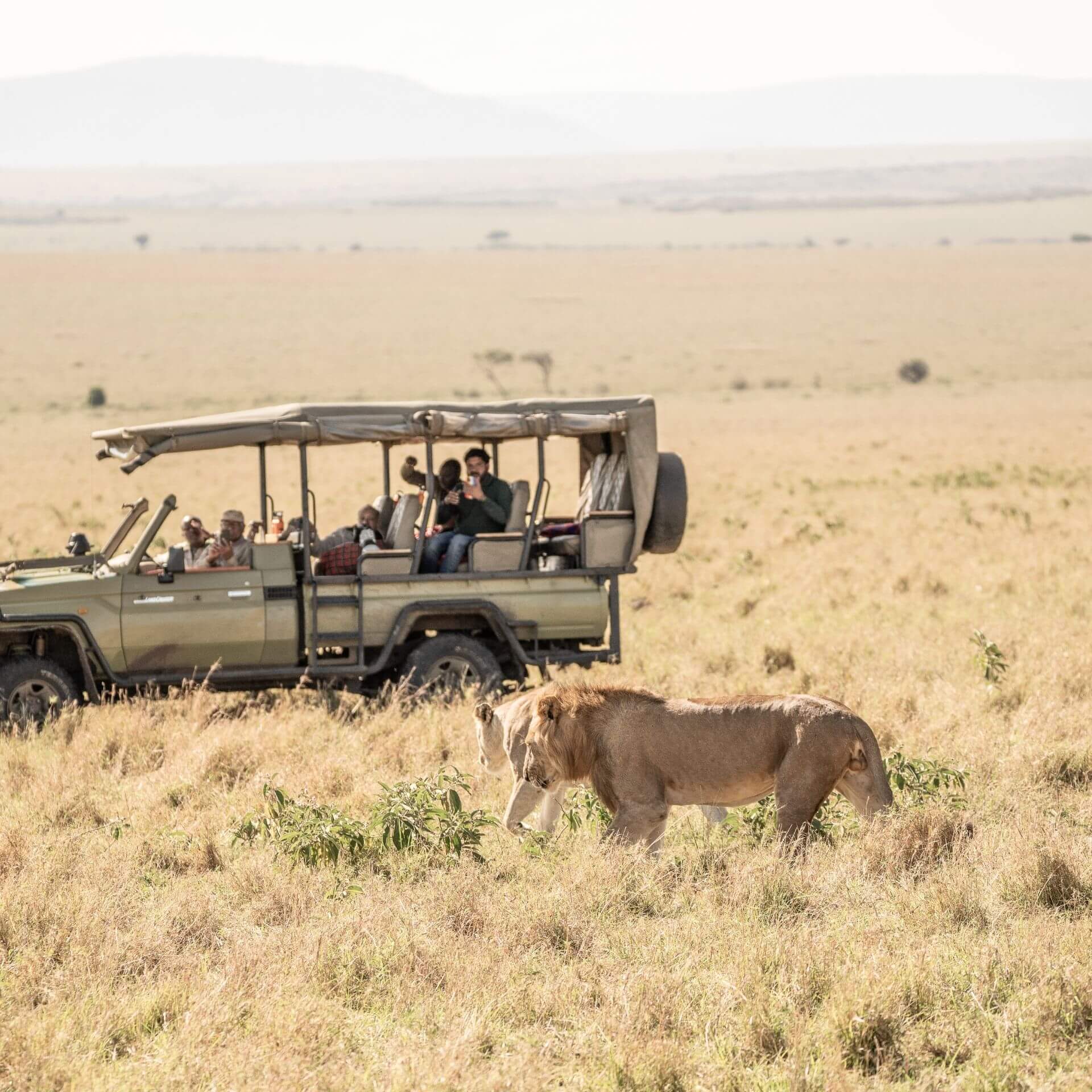Being one of the most breathtaking experiences in Africa, experiencing the wildebeest migration in Kenya or Tanzania should be on everyone’s bucket list
It was a late afternoon in the heart of Masai Mara and the light was perfect for photographing. At the horizon, the plains of the national park were dotted with thousands of animals. I was sitting on a first row seat witnessing the epic journey of thousands of wildebeest and zebras crossing in a large group from Kenya’s Masai Mara Natural Reserve to Serengeti National Park in Tanzania. But these were not the dramatic sceneries of lions and crocodiles hungry and getting ready for a hunt which you usually see on a BBC Earth or National Geographic documentary. This was just a moment of calm, harmony and probably one of the best experiences in my lifetime.
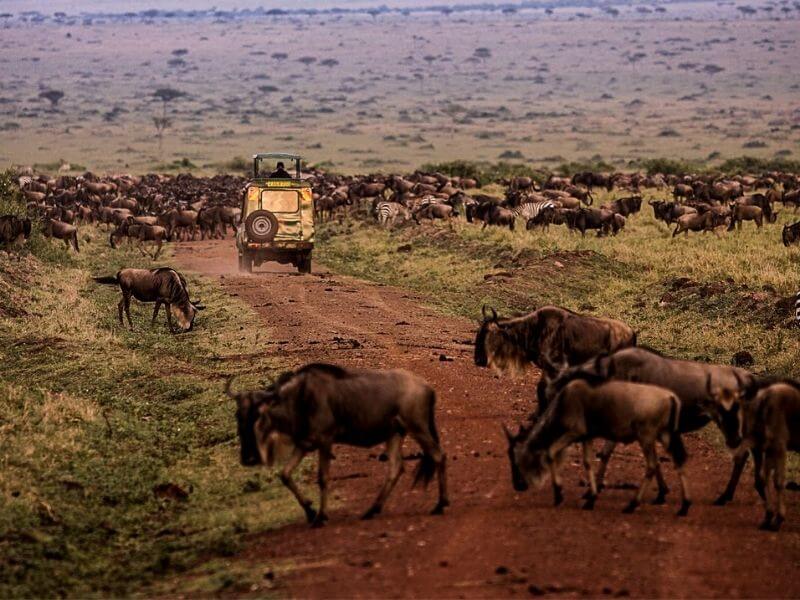
With over 2 million wildebeest constantly migrating in circles between Kenya and Tanzania, experiencing the wildebeest migration can be as wild, calm or as bizarre as you want it. From seeing over 8000 wildebeest babies born each day during calving season, to patiently waiting for the wildebeest to cross the Mara river and hope to see the carnage of crocodiles attacking the defenseless animals – there is something for everyone.
Why do wildebeest migrate
With the sole purpose of following the rain, herds of zebras, antelope and wildebeest migrate all year round between Kenya and Tanzania. It is a cycle they do their whole lives and since the rainfall is determined by the seasons and changes in climate, there is no way to predict the exact timing of the rainfall and the movement of these herds.
Read more: How to plan a trip to Masai Mara in Kenya
Read more: How to cross overland from Kenya to Tanzania
Read more: Which are the best national parks in Zambia

But don’t worry, travelers planning to visit Masai Mara or Serengeti can get a rough idea where the wildebeest are going to be and what kind of safari experience they can expect in their visit.
At the Serengeti National Park in Tanzania, the rainy season spans March, April and May, which makes January til May the best time to see wildebeest in Tanzania. While travelers in search for wildebeest in Masai Mara, will have their best chances from August to early November.
Read more: How to plan a visit to Amboseli National Park
Read more: How to plan the best safari in Masai Mara in Kenya
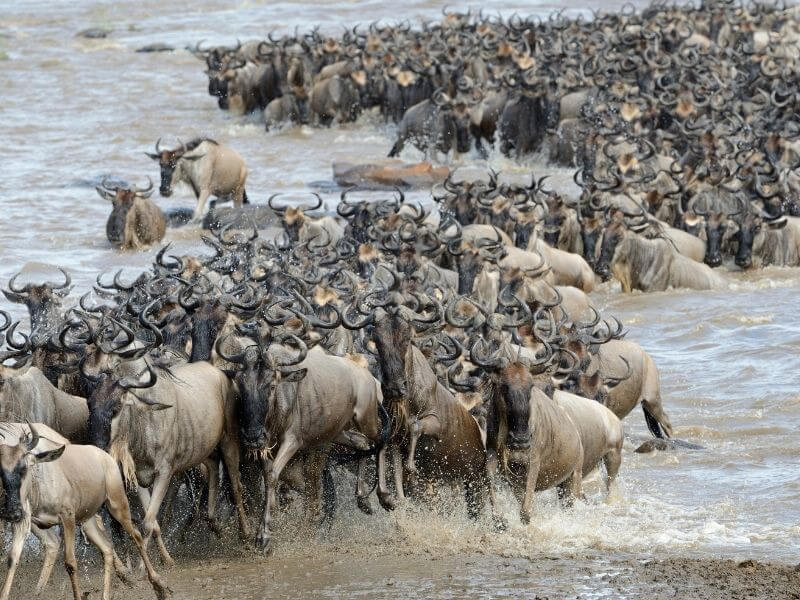
When should I see the wildebeest migration
By being a constant non-stop cycle between life and death, before you choose where do you want to travel and when, you have to decide what kind of experience are you expecting to see. Undoubtedly, river crossings are the most beloved times to experience the wildebeest migration, as the most dramatic hunting happen at this time. However, calving season offer a unique view of the migration or several other timings of the year offer wonderful sights of millions of wildebeest simply resting at the plains of Serengeti or Masai Mara.
Read more: Everything you need to know before visiting Serengeti National Park
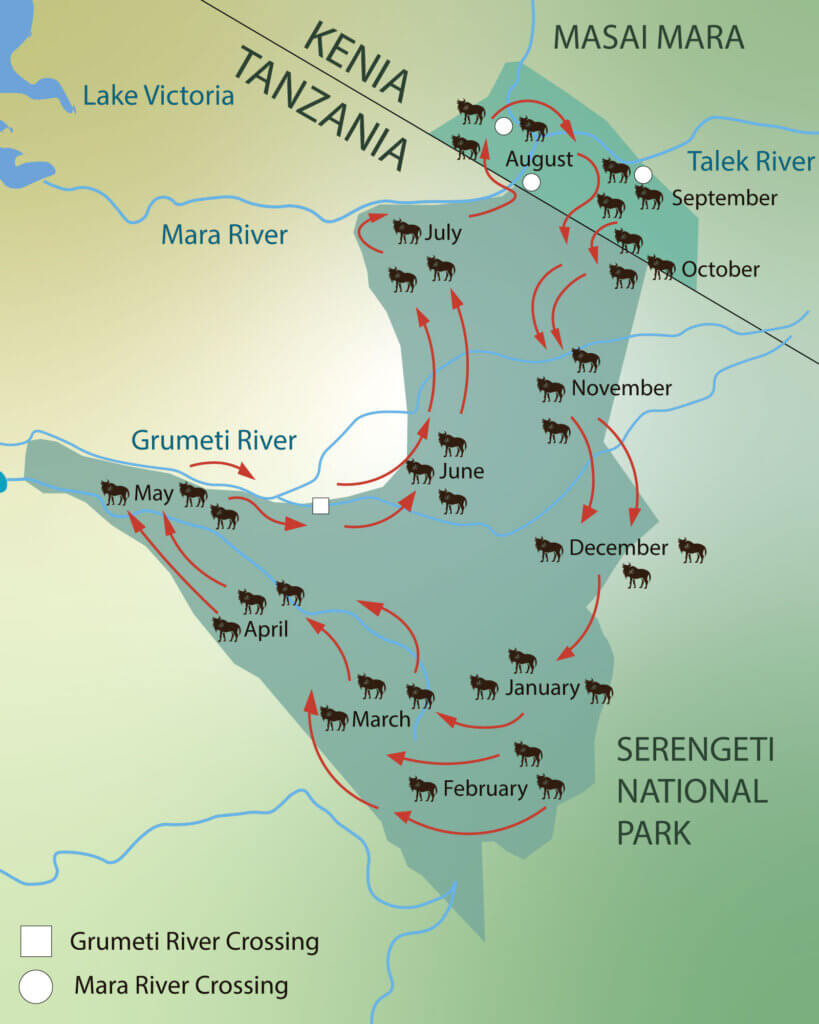
To get a rough idea what you will witness in Kenya or Tanzania, this is what happens with the Great Migration in each month of the year
January
Kenya: You will see just a few last wildebeest crossing to Tanzania
Tanzania: Most of the herds arrived in Tanzania’s Serengeti National Park and you can expect wildebeest to be moving south from the north-east region and into the area near Lake Ndutu.
Expect to see mega-herds of thousands or hundreds of wildebeest, zebras and antelopes during this time.
February – March
Kenya: The chances to see wildebeest herds are minimal
Tanzania: With calving season starting, over 10.000 wildebeest babies will be born each day. This is one of the most outstanding wildlife experiences.
Take into consideration that visiting Serengeti during calving season, means seeing life and death surrounding at all time. Predators find this a perfect opportunity to catch prey, while mother wildebeest fight for their life after giving birth.
April
Kenya: The chances to see wildebeest herds are minimal
Tanzania: With the long rains of April and May starting and the grass becoming larger and greener, wildebeest generally move towards the Moru and Simba Kopjes in south east Serengeti. As a visitor in the national park, expect to see vast groups of wildebeest and some of the most beautiful sights of the Serengeti National Park.
This is also the most accessible part of Serengeti. Therefore, viewings of the migration are 100% guaranteed.

May
Kenya: The chances to see wildebeest herds are minimal
Tanzania: As the rain slowly ends in Tanzania, long lines of up to 40 kilometers of wildebeest start their journey towards the west of Tanzania and later up to Kenya. Sceneries are perfect for a photographs and hunting is something you can expect to see quite often.
June
Kenya: With a minimal amount leading herds of wildebeest slowly arriving in Kenya’s Masai Mara Natural Reserve, you can expect to see some action and small groups of wildebeest. However, most of the best viewings are still in western Tanzania.
Tanzania: Wildebeest arrive at the Grumeti and large herds of wildebeest start splitting into smaller ones. This is one of the least accessible parts of Serengeti. Therefore, the experience can be quite private and special.
Read more: What are the top safari experiences in Africa
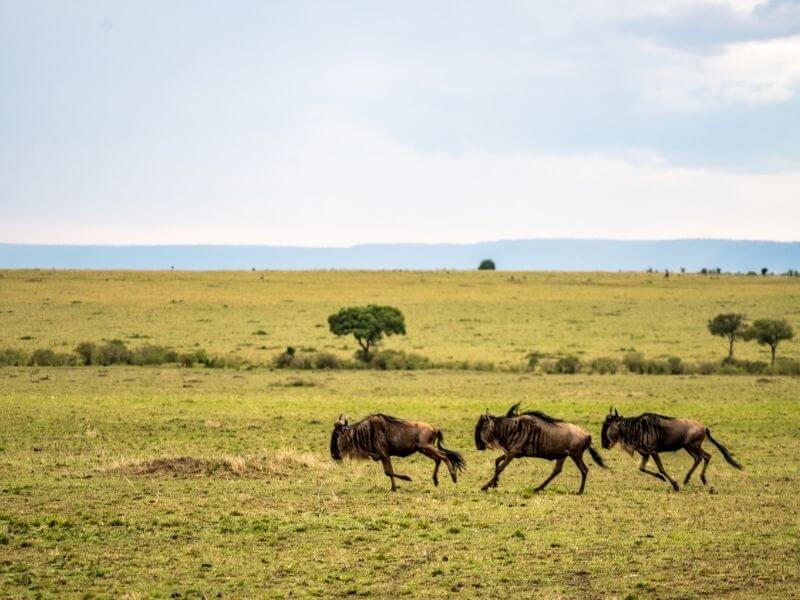
July
Kenya: Wildebeest river crossings start in Masai Mara. Expect to see the first dramatic crocodile hunts if you have enough patience, as over 1 million wildebeest cross this river in order to get to Kenya’s greener side.
Tanzania: With the wildebeest already up north of Tanzania, you will very unlikely see herds still grasping in Seronera and the eastern side of the park. Serengeti stops for several months being the best place to spot the wildebeest migration.
August
Kenya: This is considered by many the best time to visit Masai Mara. With river crossings happening on a daily basis, expect to see wild images of wildebeest, zebras and antelopes fighting for their life. This is also the most popular month in Masai Mara, so book in advance and don’t miss the trip of a lifetime.
Tanzania: The Great Migration becomes only visible at the northern end of Serengeti, where more or less half of the herds stay. Drives become long and exhausting and the national parks feels desolated in the southern and eastern part.
NOTE: It is impossible to predict river crossings. They happen very sporadically and while hundreds of animals can arrive at the edge of the Mara river, it is very difficult to know if they will cross in the next 2 minutes, 2 hours or 2 days.
Read more: How To Plan A Safari Trip On A Budget

September – October
Kenya: With more than one million wildebeest feeding in Kenya, this is the best time of the year to see groups of hundreds of thousands of wildebeest, beautiful sceneries of the national park and also dramatic encounters with the hungry predators that waited a full year for this moment.
The Masai Mara becomes the best spot in the world to do a safari trip.
Tanzania: Herds of wildebeest will be only visible in the northern side of Serengeti
November
Kenya: Wildebeest start moving slowly back to Serengeti. River crossing become way less common, but still smaller herds are visible from time to time.
Serengeti: Herds of wildebeest will be mostly visible in the northern side of Serengeti and smaller leading herds can be encountered in central Serengeti.
December
Kenya: With most herds gone to Serengeti, viewing of large groups of wildebeest becomes minimal and predators have to wait several months to feast again.
Tanzania: Serengeti becomes again the best place in the world to see millions of wildebeest and this unlimited cycle continues as the calving season starts once again.
Read more: How to start planning your first safari
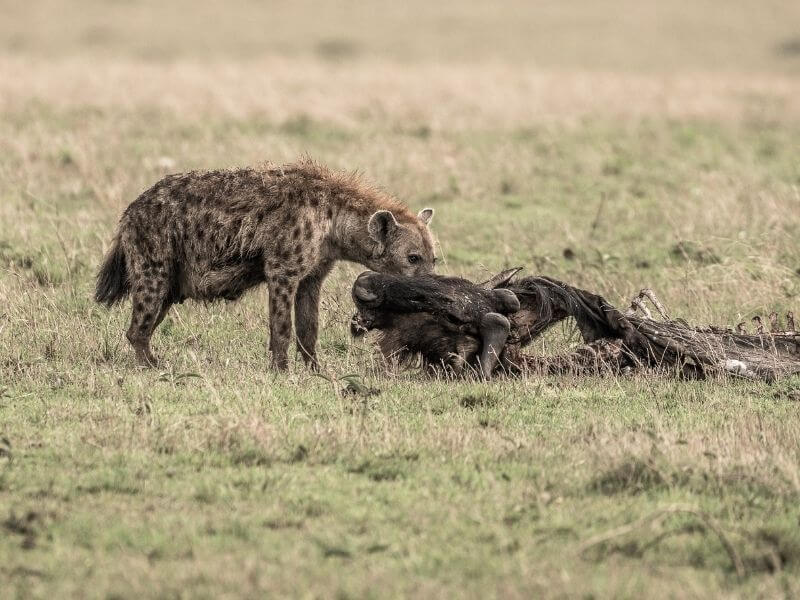
How to plan the Great Migration
If booking accommodation and activities a year in advance is too unpredictable for you, one of the best options to experience the most of the Great Wildebeest Migration is to book a mobile safari vehicle.
With a mobile safari, you will be able to follow a large herd of wildebeest on their path to Serengeti or to Masai Mara.
Take into consideration that you can’t cross the border between Kenya and Tanzania in the national park. If you want to visit Serengeti after Masai Mara or vice versa, you will have to go to Nairobi or Arusha and travel between these cities by car or flight.
I traveled in October from Masai Mara in Kenya to Serengeti in Tanzania and for this trip I had to return to Nairobi, book a van transfer to Arusha for 25 USD and from there book a tour to Serengeti National Park.
Read more: Everything you need to know before traveling to Serengeti

How much it cost to see the Great Wildebeest Migration
As one of the best travel experiences in the world, the Great Migration is also one of the most expensive ones. Masai Mara and Serengeti are already some of the most expensive national parks in the world. However, during calving season, and river crossing season, expect tour operators to charge up to 30-40% more.
Additionally, take into consideration that accommodation and vehicles get book by travelers from all over the world months in advance and planning an affordable trip can be almost impossible.
Read more: Everything you need to know about traveling to Masai Mara

After asking safari experts and tour operators from Kenya and Tanzania, they both agreed that the best month when it comes to value/experience ratio is early November in Masai Mara. Small herds of wildebeest are still at the southern side of Masai Mara and viewing can still be excellent. This month is also right after high season. Prices are lower and availability is good.
It is also good to take into consideration that fees to enter Masai Mara are way lower than in Serengeti and a good private safari trip for 4 days can get easily booked under 1000 USD – a price that is basically impossible at any time in Serengeti.
How to take great photographs during the Great Wildebeest Migration?
Situations happen fast. Wildebeest are grasping in the grasslands of the national park and from one moment to another predators appear and the whole atmosphere changes. Photographing dramatic experiences during the wildebeest migration has been one of the most complex situations I encountered, but also one of the most rewarding ones.
Read more: All you need to know before a road trip in Malawi

First of all, get a camera lens with a length over 200mm. Animals are quite distant from you and a normal phone camera won’t catch the majesty of the moment.
Keep also some extra batteries and memory cards with you. Photographers capturing the migration photograph up to 1000 photographs per day. Batteries run off very quickly and memory cards too.
Additionally, discuss with your guide what kind of experience you want to photograph. They are experts who understand animal behaviour in almost each situation. They are the best person to tell you when a crossing might happen, when a predator will go on a hunt or when a wildebeest knows something is wrong around him.
And finally, ask for your tour operator for a camera beam bag. That makes one of the biggest difference when it comes to be comfortable and not run of out patience. In most situations I simply left my camera on top of the beam bag and waited for the right moment to happen.
Planning a trip to Kenya independently is fun. However, if you want to arrange everything with tour operators beforehand from the comfort of your home. SafariBookings is the best platform for it.
They have the largest database of tour operators in Africa and you can simply send a request and negotiate a tour and a price directly with the operator. You don’t have to pay any additional fees.
These are some of the most popular tours in Masai Mara at SafariBookings

